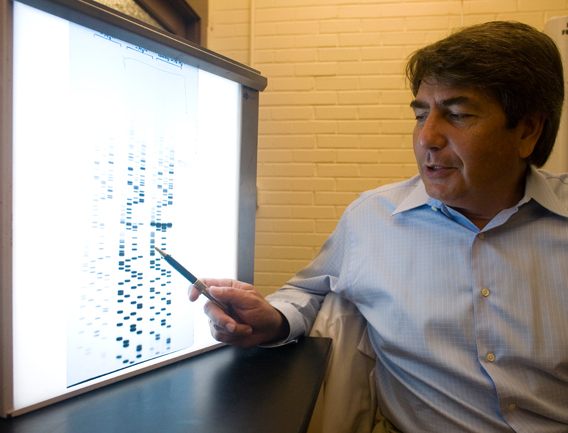Palindromes and Chromosomes
A new clue to the origin of genomic instability that leads to cancer
In the past decade, researchers have observed that many kinds of cancer are associated with areas in the genome-the genetic makeup of living things-where chromosomes break. More recently, scientists have discovered that slow or altered replication of DNA as cells divide can cause such chromosomal breaking.

"Stalled DNA replication could result in the chromosomal breakage during cell division," says Sergei Mirkin. Photo: Melody Ko
Now researchers at Tufts have identified one reason for slow DNA replication. It's a peculiar effect in which the DNA contain longer-than-normal palindrome sequences. They have also found two proteins in yeast cells that perhaps can mitigate the problem.
DNA is essentially the blueprint for genetic transmission. It contains four bases-adenine, thymine, guanine and cytosine, abbreviated as A, T, G and C-that are arranged in various triplets, such as GCC or AGT, to code for proteins. Occasionally, there will be a section of DNA with sequences that are palindromes-something that reads the same backwards and forwards.
In a recent paper in the Proceedings of the National Academy of Sciences, Sergei Mirkin, the White Family Professor of Biology, and graduate student Irina Voineagu, along with colleagues from the Georgia Institute of Technology, reported their findings on the phenomena.
Mirkin and his team studied palindrome behavior in bacterial, yeast and mammalian cells, which allowed them to monitor DNA replication in a more detailed way than looking at human chromosomes. Based on previous studies, they expect their findings are applicable to human chromosomes.
Abnormal Shapes
We normally associate palindromes with the spoken or written word. "A man, a plan, a canal-Panama!" is one that Mirkin points to. When short, they make perfect sense and are easy to remember. But when they are long, they take longer to decipher. "For example, try saying 'A man, a plan, a cat, a ham, a yak, a yam, a hat, a canal-Panama,' " Mirkin notes.
The same is true for DNA palindromes: the longer they get, the slower they replicate. Previous DNA research had shown that long palindromes change the shape of a molecule from a double helix into a hairpin-like structure in a test tube. It was not known, however, if similar changes occur inside cells and, if so, how they would affect DNA functioning. In this study, the researchers found that long palindromes stall the DNA replication.
"Replication is carried out by a complex and sophisticated machinery, which has many levels of checks and balances to prevent 'typos' from happening," says Mirkin, meaning that instead of CGA AGC, for instance, the copy might read CGA ACG. "Long DNA palindromes, however, can occasionally jam this powerful replication machinery."
The researchers were also able to pinpoint the exact structure causing DNA malfunction. "In all cases, it was the formation of the hairpin-like DNA structure in a palindrome that caused the replication to stall," he says.
Other scientists have previously found that when replication slows down, chromosomes break. "Stalled DNA replication could result in the chromosomal breakage during cell division, explaining why DNA palindromes are genomic weak spots," Mirkin says.
In yeast cells, Mirkin and his team found that two proteins within the cell-Tof1 and Mrc1-enabled replication to proceed through the hairpin-like DNA structures. "These proteins might be key players in protecting the genome from breaking at DNA palindromes," he says.
Mirkin, whose work is funded by the National Institutes of Health, says he has begun experiments to see if the same results will be observed with human equivalents of these proteins.


